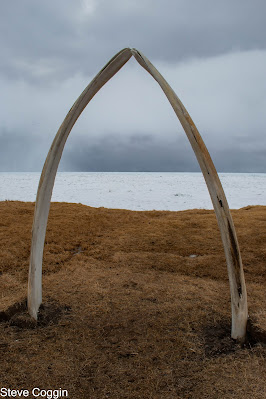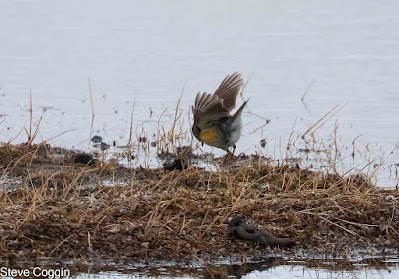 |
| Whale Bone Arch. This arch made from the ribs of a Bowhead Whale (Balaena mysticetus) commemorates the whaling tradition of the Inupiat people. Utqiagvik, Alaska. |
Utqiagvik, Alaska, the northernmost town in the United States, lies at 71 degrees north latitude. With a population of about 5000, Utqiagvik perches on the edge of the Arctic Ocean 300 miles north of the Arctic Circle. The North Pole is 1300 miles north with nothing but a frozen but melting ocean barring the way. The town is not connected to the rest of the world by road and can only be reached by boat, when the sea is clear of ice, or by aircraft.
 |
| Traditional whaling boat. Utqiagvik, Alaska. |
Inupiat people have lived in the area for 1500 years and continue there today. They hunt Bowhead Whales from small boats, continuing a tradition that has lasted more than a millennium. They also hunt seals and take birds for food. Utqiagvik is surrounded by low lying tundra, with many small lakes and ponds. All this is underlain by permafrost. For much of the 19th and 20th centuries Utqiagvik was known as Barrow, named for nearby Point Barrow. The name of the town was changed back to Utqiagvik by referendum in 2016.
 |
| Pectoral Sandpiper (Calidris melanotos). Utqiagvik, Alaska. |
 |
| Pectoral Sandpiper. Utqiagvik, Alaska. |
Diane, two friends and I visited Utqiagvik in June to see this
unique place and the birds that were beginning to nest on the tundra. Shorebirds were abundant and despite the
persistent snow, they were pairing up and mating. Pectoral Sandpipers (Calidris melanotos),
with their streaky, puffed-out breasts and rich, repeated call were the most
abundant of the sandpipers.
 |
| Dunlin (Calidris alpina). Utqiagvik, Alaska. |
 |
| Semipalmated Sandpiper (Calidris pusillla). Utqiagvik, Alaska. |
Dunlins (Calidris alpina) and Semipalmated Sandpipers (Calidris pusilla) were in their breeding plumage and much more colorful than when we see them in the south during winter.
 |
| Female Red-necked Phalarope (Phalaropus lobatus) sitting on nest. Utqiagvik, Alaska. |
 |
| Female and male Red-necked Phalarope. Utqiagvik, Alaska. |
 |
| Female Red Phalarope (Phalaropus fulicarius). Utqiagvik, Alaska. |
 |
| Male Pacific Golden Plover (Pluvialus fulva). Utqiagvik, Alaska. |
 |
| Female Pacific Golden Plover. Utqiagvik, Alaska. |
 |
| A large flock of King Eiders (Somateria spectabiliis) flying over the frozen Arctic Ocean. Utqiagvik, Alaska. |
 |
| Greater White-fronted Goose (Anser albifrons). Utqiagvik, Alaska. |
 |
| Snow Geese (Anser caerulescens). Utqiagvik, Alaska. |
 |
| Tundra Swans (Cygnus columbianus). Utqiagvik, Alaska. |
Ducks, geese and swans are common nesters on the tundra. King Eiders (Somateria spectabilis) were not nesting when we visited but there were large flocks flying over the sea ice. Greater White-fronted Geese (Anser albifrons) breed across Northern parts of North America and Eurasia. These medium-sized geese have orange legs, a pink bill, brown body and black bars on the belly and were pairing up to nest. A flock of Snow Geese (Anser caerulescens) did a flyby in the brilliant arctic sun. This group of Snow Geese were the white phase with black wingtips. Tundra Swans (Cygnus columbianus) were also in breeding pairs in the tundra ponds. These white swans build nests of plant material at the edge of ponds and lay 3-5 eggs.
 |
| Male Lapland Longspur (Calcarius lapponicus). Utqiagvik, Alaska. |
 |
| Female Lapland Longspur. Utqiagvik, Alaska. |
The diversity of perching birds around Utqiagvik is low but the ones present are quite striking. Lapland Longspurs (Calcarius lapponicus) are sparrow sized birds that nest on the tundra and have a circumpolar breeding range. A male Lapland Longspur has a black face, crown, throat and breast. A white line runs from behind the eye to the belly and the belly is white with black stripes. The back of the neck is chestnut brown, and the small beak is yellow. Females have a similar pattern but lack the black on the face and throat. Lapland Longspurs migrate south in winter and live in open country.
 |
| Snow Bunting (Plectrophenax nivalis). Utqiagvik, Alaska. |
Snow Buntings (Plectrophenax nivalis) are black and white relatives of Lapland Longspurs. Males, with their white heads and black-and-white backs and wings standout on the tundra where they nest. Females have brown feathers on their heads and backs. Like Lapland Longspurs, Snow Buntings have a circumpolar distribution and migrate south in winter. We regularly see Snow Buntings on the Outer Banks of North Carolina in the winter where their plumage is light brown and white.
 |
| Red-flanked Bluetail (Tarsiger cyanurus). Utqiagvik, Alaska. |
 |
| Red-flanked Bluetail. Utqiagvik, Alaska. |
 |
| Red-flanked Bluetail. Utqiagvik, Alaska. |
 |
| Arctic Fox (Vulpes legopus). Utqiagvik, Alaska. |
We also had some mammal encounters during our stay in Utqiagvik. An Arctic Fox (Vulpes lagopus), that was transitioning from its winter white fur to summer gray, ran across a snow-covered field. We saw Bowhead Whale (Balaena mysticetus) skulls along the shore of the Arctic Ocean. These skulls were evidence of successful whale hunts by the Inupiat people.
 |
| Bowhead Whale skull. Utqiagvik, Alaska. |
And there were Polar Bears (Ursus maritimus). Every time we looked out on the frozen ocean there were bears. We learned to look for a yellowish smudge on the blue-white ice. Each of these smudges was a bear. We saw a female with a couple of cubs. We saw single bears, and some were feeding on marine mammals. In preparation for this trip, we read about the dangers of Polar Bears, the largest land predator in the world. The bears we saw were far out on the ice and the land was so open, we were in no danger of being surprised.
 |
| Polar Bear (Ursus maritimus) on sea ice (inside the red circle). Utqiagvik, Alaska. |
Our visit to Utqiagvik, at the northern extreme of the northernmost state, revealed plenty of surprises. The wide-open landscape of tundra, sea and sky is filled with life. Native people are maintaining cultural traditions and the birds and mammals are thriving at 71 North.
Beautiful photography and a great travelogue
ReplyDeleteThanks Sheila.
Delete